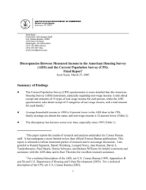Discrepancies Between Measured Income in the American Housing Survey (AHS) and the Current Population Survey (CPS): Final Report
Discrepancies Between Measured Income in the American Housing Survey (AHS) and the Current Population Survey (CPS): Final Report
The Current Population Survey (CPS) questionnaire is more detailed than the American Housing Survey (AHS) instrument, especially regarding non-wage income: it asks about receipt and amounts of 19 types of non-wage income for each person, while the AHS questionnaire asks about receipt of 9 categories of non-wage income, and a total amount for each family.
Average household income in 1999 is 9 percent lower in the AHS than in the CPS; family earnings are almost the same; and non-wage income is 32 percent lower (Table 2).
The discrepancy has become worse over time, especially since 1995 (Table 1).
The problem is more due to the failure of many respondents to report any non-wage income, than to wrong amounts being reported (Tables 3, 4, and 8).
Underreporting of non-wage income increases with the number of adults in the household, suggesting that the CPS’s practice of asking about each person makes a difference (Table 5). This finding is confirmed by logit analysis that holds demographic background characteristics constant (Table 13).
The largest potential sources of underreported non-wage income are interest, dividends, social security and pensions, “other income,” and business income. “Potential” means, for example, that if AHS respondents could be induced to report receipt at CPS rates, and they reported amounts similar to CPS amounts, interest income would rise by $861 on average. Social security and pension income would rise by $575 (Table 8).
Those with business income in the AHS report 49 percent more earnings than in the CPS (Table 10). This overreporting of earnings is not found for those reporting any other source of non-wage income. The extra earnings in the AHS may consist of self- employment income that is being mis-reported on the wage line rather than the non-wage section. This finding holds true when adjusted for demographic background characteristics (Table 14).
There has been a large increase in the amount of earnings reported by AHS respondents with business income between 1995 and 1999. If the increase is all misreported non- wage (self-employment) income, 33 percent of the discrepancy in non-wage income, and 50 percent of the increase in the discrepancy would be explained. (Table 14).
A reanalysis of the 1991 Computer-Assisted Telephone Interviewing (CATI) experiment indicates that CATI reduces non-wage income by $308 on average, which is statistically significant at the ten percent level, and causes a corresponding $219 increase in earnings, which is not statistically significant. I speculate that these are the effects of a computerized instrument (like the one used today), but there were other differences between the CATI and paper instrument procedures. These amounts are small, compared to the AHS/CPS discrepancies (Table 15).
For families receiving business income, CATI raises earnings by $7,392 on average and correspondingly lowers non-wage income by $5,985. CATI has little effect on the fraction reporting the receipt of business income, however. Combined with the non- experimental evidence, this is strong support for the idea that AHS respondents are reporting self-employment income as wages, and that this phenomenon has increased with the switch to a computerized questionnaire. (Table 16)
The CPS counts several sources of income that the AHS does not: educational and financial assistance. This accounts for roughly 10 percent of the gap in non-wage income (Appendix, Appendix Table A1).




